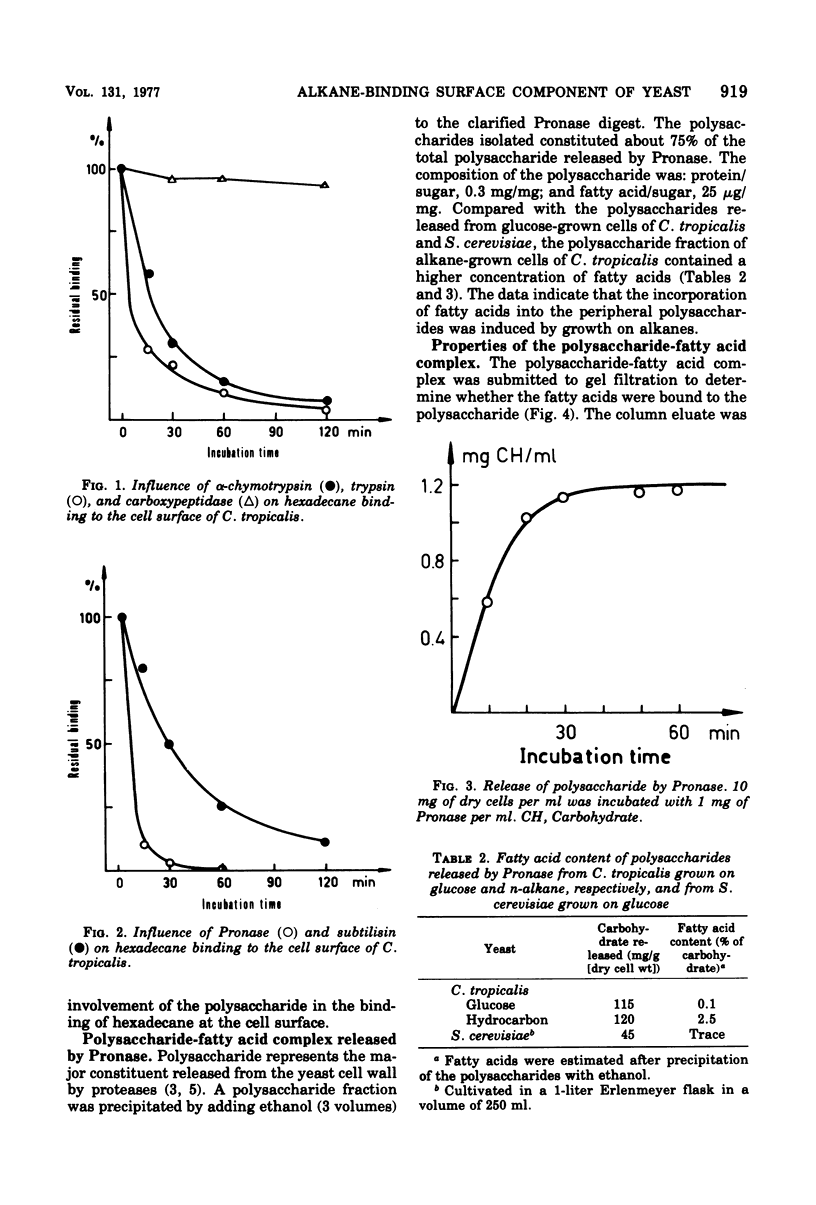Abstract
A polysaccharide-fatty acid complex was isolated from the cell surface of Candida tropicalis growing on alkanes. This complex was solubilized by Pronase treatment of whole cells. A decrease in alkane-binding affinity was observed after Pronase treatment, resulting in 10 to 12% of the yeast dry cell weight being released as polysaccharide. The isolated polysaccharide contained 2.5% fatty acids. C. tropicalis and Saccharomyces cerevisiae grown with glucose contained only traces of fatty acids in the corresponding polysaccharide fraction. The fatty acids were not removed from the polysaccharide moiety by gel filtration. Extraction of the polysaccharide with chloroform-methanol showed that fatty acids were covalently bound to the polysaccharide. The amphipathic nature of the isolated polysaccharide and the hydrocarbon-induced formation suggest a possible role in alkane metabolism.
Full text
PDF




Selected References
These references are in PubMed. This may not be the complete list of references from this article.
- Appelqvist L. A. A simple and convenient procedure for the hydrogenation of lipids on the micro- and nanomole scale. J Lipid Res. 1972 Jan;13(1):146–148. [PubMed] [Google Scholar]
- Ballou C. E. Some aspects of the structure, immunochemistry, and genetic control of yeast mannans. Adv Enzymol Relat Areas Mol Biol. 1974;40(0):239–270. doi: 10.1002/9780470122853.ch6. [DOI] [PubMed] [Google Scholar]
- EDDY A. A. [The structure of the yeast cell wall. II. Degradative studies with enzymes]. Proc R Soc Lond B Biol Sci. 1958 Dec 17;149(936):425–440. doi: 10.1098/rspb.1958.0085. [DOI] [PubMed] [Google Scholar]
- Hug H., Blanch H. W., Fiechter A. The functional role of lipids in hydrocarbon assimilation. Biotechnol Bioeng. 1974 Jul;16(7):965–985. doi: 10.1002/bit.260160709. [DOI] [PubMed] [Google Scholar]
- Kaeppeli O., Fiechter A. The mode of interaction between the substrate and cell surface of the hydrocarbon-utilizing yeast Candida tropicalis. Biotechnol Bioeng. 1976 Jul;18(7):967–974. doi: 10.1002/bit.260180709. [DOI] [PubMed] [Google Scholar]
- LOWRY O. H., ROSEBROUGH N. J., FARR A. L., RANDALL R. J. Protein measurement with the Folin phenol reagent. J Biol Chem. 1951 Nov;193(1):265–275. [PubMed] [Google Scholar]
- Moo-Young M., Shimizu T. Hydrocarbon fermentations using Candida lipolytica. II. A model for cell growth kinetics. Biotechnol Bioeng. 1971 Nov;13(6):761–778. doi: 10.1002/bit.260130604. [DOI] [PubMed] [Google Scholar]
- Rylkin S. S., Berezov T. B., Gurina L. V., Belova L. A., Shul'ga A. V. O sostave kletochnoi stenki drozhzhei Candida tropicalis pri roste na gliukoze i n-alkanakh. Mikrobiologiia. 1974;43(3):551–552. [PubMed] [Google Scholar]


